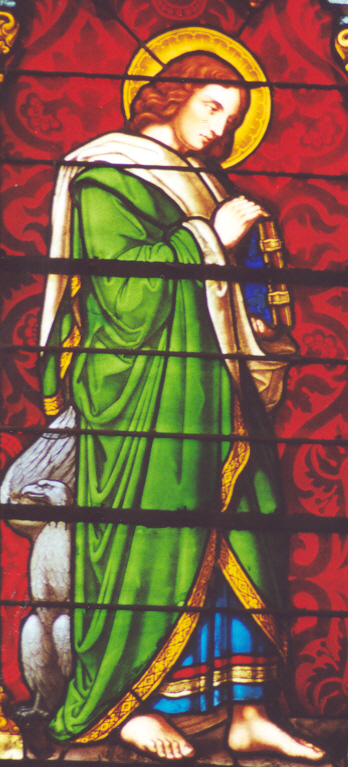
Feast of the Exaltation of the Holy Cross
September 14, 2017
A Homily - Cycle A - 2016-2017
by Deacon John P. Allen
First Reading - Numbers 21:4b-9
Responsorial Psalm - Psalm 78:1bc-2, 34-35, 36-37, 38
Second Reading - Philippians 2:6-11
Gospel - John 3:13-17
Home Page
A
Priest Speaks Chapter/Verse
John wrote to show that Christ was
the Messiah, the Divine Son of God.

Jesus said to Nicodemus: "No one has gone up to heaven except the one who has come down from heaven, the Son of Man. And just as Moses lifted up the serpent in the deseert, so must the Son of Man be lifted up, so that everyone who believes in him may have eternal life."
For God so loved the world that he gave his only Son, so that everyone who believes in him might not perish but might have eternal life. For God did not send his Son into the world to condemn the world, but that the world might be saved through him.
Today is the Feast of the Exaltation of the Holy Cross. We recall a significant event in Christian history. More importantly we celebrate this feast as a reminder that the cross is at the very heart of our faith.
In the year 326 A.D., St. Helena, the mother of Constantine, the first Christian Emperor of Rome, traveled to the Holy Land in search of the places where the major events in Jesus' life had occurred. (There seems to be something in the human heart that leads one to seek to commune with the divine - to see and to touch the earthly objects most intimately associated with one's faith, even when doing so requires long, difficult travel. Certainly, this was the case for Helena since she was almost 80 years old)!
Much had changed in Palestine since the time of Jesus. The Romans had totally destroyed Jerusalem in 135 A.D. and rebuilt it as a Roman City, prohibiting Jews from even living there. With the conversion of Constantine, free access to the Holy Land again became possible and the age of pilgrimage began. Helena's quest was made easier since the Roman emperor Hadrian had erected pagan shrines over several of the holy places to defame them and to remind any would-be pilgrims that Rome had vanquished prior religious beliefs and practices.
When she arrived at Mount Calvary and the nearby tomb of Jesus Helena found them marked by temples, to Jupiter and Venus, respectively. A Jew named Judas gave her the precise location on Calvary where the cross had been buried. She ordered the site excavated and discovered three crosses, apparently that of Jesus and those of the thieves. She and the Bishop of Jerusalem were able to distinguish the cross of Jesus because a woman near death was healed by touching that particular one. Constantine then ordered that churches be built over Calvary and the burial site. These churches were dedicated on September 13th and September 14th 335.
These two churches were destroyed later by the Moslems. During the Crusades, a single new structure, the Church of the Holy Sepulcher, replaced them. By the middle ages, the Church of the Holy Sepulcher had become the holiest destination for Christian pilgrims and, of course, it remains so now. I would urge you to visit this great shrine if you are able to. My wife has been blessed to visit there twice. No doubt, the prayers for carious pilgrims are quite individual. For me, what was most meaningful was to simply tell Our Lord thank you for what He has done for us.
But today, we are celebrating far more than an archeological discovery - despite its deep emotional significance to Christians. We are celebrating the Cross of Jesus as the tangible sign of His victory over evil and His restoration of us as sinners into the love of God the Father.
The tenor of today's feast differs somewhat from that of Good Friday when the focus is on the cross as the instrument of Jesus' suffering and death. Today is a joyful feast. We celebrate the cross as the image of victory and hope.
Probably none of those present at Jesus' crucifixion could have conceived that someday the cross would ever be so revered. To them, the cross was the most hated instrument of torture. No one would have been interested in retrieving the cross, let alone revering it!
With Jesus' appearances after Easter, and especially under the power and inspiration of the Holy Spirit at Pentecost, things would change. The cross would come to be seen in an entirely new light. On the evening of His resurrection and again a week later, specifically to Thomas, Jesus demonstrated His identity to the apostles. He showed them His pierced hands and feet that had been nailed to the cross. They recognized Jesus and saw His victory over death as they were reminded of His crucifixion.
God, of course, could have reconciled us to Himself in any way that He chose. In accepting suffering and death on a cross as the means of reconciliation, Jesus has left no room for us to doubt how much He values us. God did not spare even His son from suffering greatly!
As His followers, we too have also been commanded by the Lord to take up our cross and follow Him. We join our individual crosses to that of Jesus. It is the cross that gives our lives meaning. As we contemplate the cross, we are also confident in the victory of eternal life that will ultimately reward our sufferings.
Home Page
A
Priest Speaks Chapter/Verse